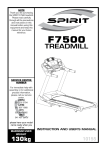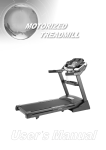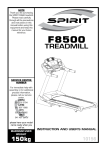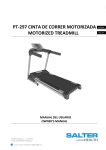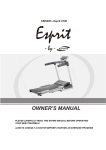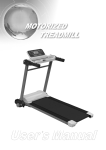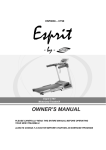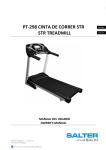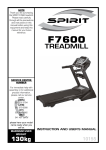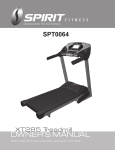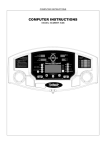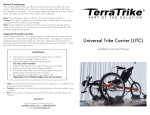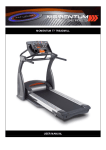Download functions - northwick.eu
Transcript
SAFETY HINTS IMPORTANT: THIS UNIT IS INTENDED FOR HOUSEHOLD USE ONLY SAFETY PRECAUTIONS Thank you for purchasing our product. Even though we go to great efforts to ensure the quality of each product, occasional errors and/or omissions do occur. In any event should you find this product to be defective or missing a part please contact our Customer Service Department. Your treadmill was designed and built for optimum safety. However, certain precautions apply whenever you use your treadmill. Be sure to read the manual before assembly and operation. Also, please note the following safety precautions: DANGER: To reduce the risk of electric shock, always unplug the treadmill from the electrical outlet immediately after using and before cleaning. 1. Read OWNER OPERATING MANUAL and all accompanying literature and follow it carefully before using your treadmill. 2. If dizziness, nausea, chest pains, or any other abnormal symptoms are experienced while using this equipment, STOP the workout at once. CONSULT A PHYSICIAN IMMEDIATELY. 3. Never leave the treadmill unattended when plugged in. Unplug from the outlet when not in use and before removing or replacing parts. 4. Never operate the treadmill if it has a damaged cord or plug, if it is not working properly, if it has been dropped, damaged, or exposed to water. 5. Do not pull the treadmill by the power supply cord or use cord as a handle. Keep cord away from heated surfaces and open flames. 6. Fitness equipment must always be installed and used on a flat surface. Do not use outdoors or near water. 7. Do not insert any objects into any openings. 8. Keep children and pets away from this equipment at all times while exercising. 9. Handicapped individuals should have medical approval and close supervision when using this treadmill. 10.Do not place hands or feet under the treadmill. Always keep hands and legs off of the treadmill when others are using it. 11.Never turn on treadmill while standing on treadbelt. Always return the treadmill to slow speed to provide for safe dismount and low speed restart. a-To disconnect, turn all controls to the off position, then remove plug from outlet. b-Use the treadmill only for it is intended use as described in this manual. c-Warm up 5 to 10 minutes before each workout and cool down 5 to 10 minutes afterward. This allows your heart rate to gradually increase and decrease and will help prevent straining muscles. d-Never hold your breath while exercising. Breathing should remain at a normal rate in conjunction with the level of exercise being performed. e-Start your program slowly and very gradually increase your speed and distance. f-Always wear suitable clothing and footwear while exercising. Do not wear loose fitting clothing that could become entangled with the moving parts of your treadmill. g-Do not walk or jog barefoot, in stocking feet or loose fitting shoes or slippers. h-Care must be taken when lifting or moving the equipment, so as not to injure your back. Always use proper lifting techniques. 12. If the supply cord is damaged, it must be replaced by the manufacturer, its service agent or similarly qualified persons in order to avoid a hazard. 13. The appliance is not to be used by children or persons with reduced physical, sensory or mental capabilities, or lack of experience and knowledge, unless they have been given supervision or instruction 14. Children being supervised not to play with the appliance WARNING: Before beginning any exercise program consult your physician. This is especially important for individuals over the age of 35 or persons with pre-existing health problems. Read all instructions before using any fitness equipment. We assume no responsibility from personal injury or property damage sustained by or through the use of this product. CAUTION!! Please be careful when opening this unit. 1 SZ610A-A923CE_1007A INTRODUCTION The treadmill has been designed and constructed to provide trouble free usage and enjoyable exercise. You can greatly improve your understanding and benefits of exercising by carefully reading the instructions given in this manual. Please familiarize yourself with the maintenance advice provided for you. SPECIFICATIONS Drive Motor: 3.5 hp Speed Range: 1 – 18 kmph Running Surface: 510 m/m x 1525 m/m Incline Level: 0-15 Levels Folding Design: Manual Fan Assembly Speaker Console Incline Adjustment Switch Handgrip Tube Safet Speed Adjustment Switch Handrail Running Belt Wheel Main Frame MAX.USER WEIGHT 150 KGS 2 ASSEMBLY PACK CHECK LIST ASSEMBLY PACK CHECK LIST #134. M5 × 10 m/m Phillips Head Screw (8 pcs) #130. 5/16" × 1/2" Button Head Socket Bolt (8 pcs) #128. M5 Speed Nut Clip (6pcs) Split Washer (4pcs) #122. 3.5 × 12 m/m Sheet Metal Screw (4 pcs) #120. 5 × 16 m/m Tapping Screw (6 pcs) #113. ψ10 #151. 5/16" × 3/4" Button Head Socket Bolt (4pcs) #133. 3/8" × 1-3/4" Button Head Socket Bolt (4pcs) #30.Lubricant (1pc) #75.Ellipse Safety Key (1pc) #132.M6 Allen Wrench (1pc) #131. Combination M5 Allen Wrench & Phillips Head Screw Driver(1 pc) 3 ASSEMBLY ASSEMBLY ■ Step 1. Remove the treadmill from the carton and lay it aside on a hard, level surface. ■ Step 2. 1. Install the 6pcs of Speed Nut Clip (128) on the Frame Base left and right side. 2. Install the Frame Base Caps (L, R)(61,62) through the Handrails (L, R)(4,5), and connect the Computer Cable (Lower)(49) and Computer Cable (Middle)(50). 61 5 62 4 50 49 4 ■ Step 3. Install the Handrails (L, R)(4,5) into the Frame Base (2) with the 8pcs of 5/16”x1/2” Button Head Socket Bolts (130) by using the Combination M5 Allen Wrench & Phillips Head Screw Driver (131). ■ Step 4. Install the Frame Base Caps (L, R)(61,62) on the Frame Base (2) with the 6pcs of 5x16mm Tapping Screws (120) by using the Combination M5 Allen Wrench & Phillips Head Screw Driver (131). ■ Step 5. Connect the Speed Adjustment Switch W/Cable (54) and Speed Cable (Upper)(37). Connect the Incline Adjustment Switch W/Cable (55) and Incline Cable (Upper)(38). Connect the Computer Cable (Middle)(50) and Computer Cable (Upper)(48). 5 ■ Step 6. Install the Console Assembly (52) into the Handrails (L, R)(4,5) with the 4pcs of 3/8”x1-3/4” Button Head Socket Bolts (133) and 4pcs of Ø10 Split Washers (113) by using the M6 Allen Wrench (132). ■ Step 7. Install the Left Handgrip Side Caps (L, R)(63,65), Right Handgrip Side Caps (L, R)(66,67) on the Handrails (L, R)(4,5) and Console Support (6) with the 8pcs of M5x10mm Phillips Head Screws (134) and 4pcs of 3.5x 12mm Sheet Metal Screws (122) by using the Combination M5 Allen Wrench & Phillips Head Screw Driver (131). 6 ■ Step 8. 1. Install the Handrail Support (15) between the Upright Tubes (5,4) with the 4pcs of 5/16”x 3/4” Button Head Socket Bolts (151). 2. Put the Beverage Holder (150) on the Handrail Support (15). 150 NOTE: Please Tighten All Screws After All Components Assembly Complete. 7 UNFOLDING FOLDING TRANSPORT Do not attempt to move the unit unless it is in the folded and locked position. Be sure the power cord is secured to avoid possible damage. Use both handrails to maneuver the unit to the desired position. ■ Unfoldong The Treadmill: Apply slight forward pressure* on the treadmill running deck with one hand. Pull down on the unlocking lever and slowly lower the running deck to the floor. The deck will lower unassisted when it reaches about waist high. (As shown Figure 1.) *At the rear roller area to relieve pressure on the locking system. ■ Folding The Treadmill: Make certain the treadmill is at minimum incline. Lift the treadmill running deck until it is secured by the locking telescoping tube assembly in center back of base. (As shown Figure 2&3.) ■Transport The treadmill is equipped with four transport wheels which are engaged when the treadmill is folded. After folding simply roll the treadmill away. (As shown Figure 4.) 8 ADJUSTMEANT BELT TRACKING ADJUSTMEANT If during use you notice that walking belt either shifts to the right or the left of center, first remove "Safety Key" and unplug equipment from AC power source. Using M6 Allen wrench provided, turn left rear roller adjustment as indicated below clockwise no more the 1/4" of a turn. Remove M6 Allen wrench, insert "Safety Key" and insert AC power cord into AC outlet. Turn on your treadmill and observe after running a few minutes to see if problem has been corrected. This may take several adjustments, so repeat the above procedure. 9 TREADMILL LUBRICATION Your treadmill should require little maintenance other then periodically applying lubricant. Lubricating under the treadbelt will ensure superior performance and extend its life expectancy. HOW TO CHECK TREADBELT FOR PROPER LUBRICATION? Lift one side of the treadbelt and feel the top surface of the treadboard. If the surface is slick to the touch, then no further lubrication is required. If the surface is dry to the touch, apply one packet of lubricant or half of the bottle of lubricant. HOW TO APPLY LUBRICANT? 1. Lift one side of treadbelt. 2. Pour one half of the lubricant bottle under the center of the treadbelt on the top surface of the treadboard. 3. Walk on the treadmill at a slow speed for 3 to 5 minutes to evenly distribute lubricant. NOTE: DO NOT over lubricate treadboard. Any excess lubricant that comes out should be wiped off. IMPORTANT: ONLY USE HALF THE BOTTLE OF LUBRICANT PER APPLICATION LUBRICATION SCHEDULE. 1. If it’s necessary, it’s better to lubricate half a bottle when user open carton to use at first time. 2. We suggest if user doesn’t apply lubricant at first time, after the first 25 hours of use (2-3 months ) need to apply one half bottle of lubricant. 3. Every 180 hours or 1000km of use apply one half bottle of lubricant per exact situation. 10 FUNCTIONS COMPUTER OPERATION INSTRUCTIONS Getting Started: Power the treadmill on by plugging it into an appropriate wall outlet, then turn on the power switch located at the front of the treadmill below the motor hood. Ensure that the safety key is installed, as the treadmill will not power on without it. When the power is turned on, all the lights on the display will light for a short time. Then the Time and Distance windows will display Odometer readings for a short time. The Time window will show how many hours the treadmill has been in use and the Distance window will show how many kilometers (or miles if the treadmill is set to metric readings; see maintenance for changing settings) the treadmill has gone. A message will be displayed showing the current software version. The treadmill will then enter idle mode, which is the starting point for operation. Quick-Start Operation: STEP 1: Press and release any key to wake the display up (if not already on). Note: Installing the tether key will also wake up the console. STEP 2: Press and release the Start key to begin belt movement at 1.0 km (0.5 mph), then adjust to the desired speed using the Fast / Slow keys (console or hand rail). You may also use the rapid speed keys 2 through 12 to set to a specific speed directly. 11 FUNCTIONS STEP 3: To slow tread-belt press and hold the Slow key (console or hand rail) to the desired speed. You may also press the rapid speed adjust keys, 2 through 12. STEP 4: To stop the tread-belt press and release red Stop key. Treadmill Features: Pause/Stop/Reset: STEP 1: When the treadmill is running the pause feature may be utilized by pressing the red Stop key once. This will slowly decelerate the tread-belt to a stop. The incline will go to zero percent. The Time, Distance and Calorie readings will hold while the unit is in the pause mode. After 5 minutes the display will reset and return to the start up screen. STEP 2: To resume your exercise when in Pause mode, press the Start key. The speed and incline will return to their previous settings. Pressing the Stop key twice will end the program and a workout summary will be displayed. If the Stop button is pressed a third time, the console will return to the idle mode (start up) screen. If the Stop button is held down for more than 3 seconds the console will reset. Incline: Incline may be adjusted anytime after the belt starts moving. Press and hold the Adjust ▲▼ keys (console or hand rail) to achieve desired level of effort. You may also choose a more rapid increase / decrease by selecting desired key, 2 through 12, on left hand side of console (incline). The display will indicate incline numbers as percent of grade (the same as grade of a road) as adjustments are made. Dot Matrix Center Display (Manual Operation): Ten rows of dots indicate each level of a workout. The dots are only to show an approximate level (speed/incline) of effort. They do not necessarily indicate a specific value - only an approximate percent to compare levels of intensity. In Manual Operation the Speed / Incline dot matrix window will build a profile “picture” as values are changed during a workout. There are twenty-four columns, which indicate time. The 24 columns are divided into 1/24th of the total time of the program. When the time is counting up from zero (as in quick start) each column represents 1 minute. Next to the Dot Matrix window are three LED lights labeled: Track, Speed and Incline, along with a display button. When the Track LED is lit the dot matrix displays the Track profile, when the Speed LED is lit the Dot matrix displays the Speed profile and when the Incline LED is lit the Dot Matrix displays the Incline profile. You may change the Dot Matrix profile view by pressing the Display button. After scrolling through the three profiles the Dot matrix will automatically scroll through the three displays showing each one for four seconds. The LED associated with each profile will blink while that view is displayed. One more press of the Display button will return you to the Track profile. 12 FUNCTIONS 0.4 km (1/4-mile) Track: The 0.4 km track (1/4-mile) will be displayed around the dot matrix window. The flashing dot indicates your progress. In the center of the track there is a lap counter for reference. Pulse Grip Feature: The Pulse (Heart Rate) window will display your current heart rate in beats per minute during the workout. You must use both left and right stainless steel sensors on the front cross bar to pick up your pulse. Pulse values are displayed anytime the computer is receiving a Grip Pulse signal. You may not use the Grip Pulse feature while in Heart Rate Control. Note: Refer to Important Safety Instructions (page 3) concerning Pulse Grip operation. The grip sensors may not be accurate when you are running on the treadmill. Calorie Display: Displays the cumulative calories burned at any given time during your workout. Note: This is only a rough guide used for comparison of different exercise sessions, which cannot be used for medical purposes. Auto-Pilot feature: This unique feature allows the user to instantly enter the Heart Rate Control mode at any time with the press of a button. The HR2 program button also doubles as the Auto-Pilot button. During any program the user may press the Auto-Pilot button to enter the HRC program. Your current heart rate (the heart rate you are at when you press Auto-Pilot) will be maintained automatically by the Auto-Pilot program. You may press the elevation/incline up or down buttons to change your target heart rate while in the Auto-Pilot mode. To Turn Treadmill Off: The display will automatically turn off (blank out) after 30 minutes of inactivity. This function is called sleep mode. In sleep mode, the treadmill will power down most everything except for a minimum of circuitry for detecting key presses and the safety key so it will start up again if these are activated. There is only a tiny amount of current used in sleep mode (about the same as your TV when it is turned off) and it is perfectly fine to leave the main power switch on in sleep mode. Of course you may also remove the safety key or turn off the main power switch to power down the treadmill. Optional / Speakers: There is an Audio Input Jack on the front of the console and built-in speakers. You may plug any lowlevel audio source signal into this port. Audio sources include MP3, Ipod, portable radio, CD player or even a TV or computer audio signal. There is an audio patch cable included to and also a headphone jack for private listening. Programmable Features The Series of treadmills offer five preset programs, two user defined programs, two heart rate control programs and one Manual program. To Select and start a Program: STEP 1: Press the desired program from the 10 available program keys. Then press the enter key to begin customizing the program with your personal data, or just press the start key to begin the program with the default settings. 13 FUNCTIONS STEP 2: After selecting a program and pressing enter to set your personal data, the Time window will blink with the default value of 20 minutes. You may use any of the up/down keys to adjust the time. After adjusting the time, press enter. (Note: You may press start at any time during the programming to begin with only settings you have modified at that point). STEP 3: The Calorie window will now be blinking a value, indicating your Body Weight. Entering the correct body weight will affect the calorie count. Use the Up/Down keys to adjust, and then press enter. * A note about the Calorie display: No exercise machine can give you an exact calorie count because there are too many factors which determine exact calorie burn for a particular person. Even if someone is the exact same body weight, age and height, their calorie burn may be very different than yours. The Calorie display is to be used as a reference only to monitor improvement from workout to workout. STEP 4: The Heart Rate window will now be blinking a value, indicating your Age. Entering your correct age affects the heart rate Bar Graph Display and the Heart Rate Control programs. Use the Up/Down keys to adjust, and then press enter. Your age determines the maximum heart rate you may achieve. Since the Bar Graph Display and the Heart Rate control features are based on a percentage of your maximum heart rate, it is important to enter the correct age for these features to work properly. STEP 5: The Speed window will now be blinking, showing the preset top speed of the selected program. Use the Up/Down keys to adjust, and then press enter. Each program has various speed changes throughout; this allows you to limit the highest speed the program will attain during your workout. Now press the Start key to begin your workout. User Programs: STEP 1: Select User 1 or User 2 via the PROGRAM keypad then press Enter. Note that the dot matrix display portion will light a single row of dots at the bottom (Unless there is a previously saved program). STEP 2: The clock (Time) window will be flashing. Use the up and down adjustment keys to set the program for the desired time. Press the ENTER key. This is a must to continue even if the time is not adjusted. STEP 3: The Calorie window will now be blinking, indicating a bodyweight value. Adjust the number to your bodyweight value and press enter. STEP 4: The Pulse window will now be blinking an Age value. Adjust the age and press enter. STEP 5: The first speed setting column (segment) will now be blinking. Using the Fast / Slow keys, adjust the speed to your desired effort level for the first segment then press enter. The second column will now be blinking. Note that the previous segment value has been carried over to the new segment. Repeat the above process until all segments have been programmed. STEP 6: The first column will be blinking again. The console is now ready for the incline settings. Repeat the same process used to set the speed values for programming the segments for incline. STEP 7: Press the Start button to begin the workout and also save the program to memory. 14 FUNCTIONS Programmable Operation of Your Treadmill The old motto, “no pain, no gain”, is a myth that has been overpowered by the benefits of exercising comfortably. A great deal of this success has been promoted by the use of heart rate monitors. With the proper use of a heart rate monitor, many people find that their choice of exercise intensity is either too high or too low and exercise is much more enjoyable by maintaining their heart rate in the desired benefit range. To determine the benefit range in which you wish to train, you must first determine your Maximum Heart Rate. This can be accomplished by using the following formula: 220 User’s Age = Maximum Heart Rate. If you enter your age during programming of the console the console will perform this calculation automatically. This is used for the HR control programs. After calculating your Maximum Heart Rate, you can 90 decide upon which goal you would like to pursue. The two most popular reasons for, or goals of exercise, are cardiovascular fitness (training for the heart and lungs) and weight control. The black columns on the chart above represent the Maximum Heart Rate for a person whose age is listed at the bottom of each column. The heart rate training zone for either cardiovascular fitness or weight loss is represented by two different lines, which cut diagonally through the chart. A definition of the lines’ goal is in the bottom left-hand corner of the chart. If your goal is cardiovascular fitness or if it is weight loss, it can be achieved by training at 80% or 60%, respectively, of your Maximum Heart Rate on a schedule approved by your physician. Consult your physician before participating in any exercise program. With all Heart Rate Control treadmills you may use the heart rate monitor feature without using the Heart Rate Control program. This function can be used during manual mode or during any of the nine different programs. The Heart Rate Control program automatically controls incline. CAUTION! The target value used in H-1 and H-2 programs is a suggestion only for normal, healthy individuals. Do not exceed your limits! You may not be able to obtain your chosen target. If in question, enter a higher age value that will set a lower target goal. 15 FUNCTIONS Using a Heart Rate Transmitter How to wear your wireless chest strap transmitter: 1. Attach the transmitter to the elastic strap using the locking parts. 2. Adjust the strap as tightly as possible as long as the strap is not too tight to remain comfortable. 3. Position the transmitter centered in the middle of your body facing away from your chest (some people must position the transmitter slightly left of center). Attach the final end of the elastic strap by inserting the round end and, using the locking parts, secure the transmitter and strap around your chest. 4. Position the transmitter immediately below the pectoral muscles. 5. Sweat is the best conductor to measure very minute heart beat electrical signals. However, plain water can also be used to pre-wet the electrodes (2 black square areas on the reverse side of the belt and either side of transmitter). It’s also recommended that you wear the transmitter strap a few minutes before your work out. Some users, because of body chemistry, have a more difficult time in achieving a strong, steady signal at the beginning. After “warming up”, this problem lessens. As noted, wearing clothing over the transmitter/strap doesn’t affect performance. 6. Your workout must be within range - distance between transmitter/receiver – to achieve a strong steady signal. The length of range may vary somewhat but generally stay close enough to the console to maintain good, strong, reliable readings. Wearing the transmitter immediately against bare skin assures you of proper operation. If you wish, you may wear the transmitter over a shirt. To do so, moisten the areas of the shirt that the electrodes will rest upon. Note: The transmitter is automatically activated when it detects activity from the user’s heart. Additionally, it automatically deactivates when it does not receive any activity. Although the transmitter is water resistant, moisture can have the effect of creating false signals, so you should take precautions to completely dry the transmitter after use to prolong battery life (estimated transmitter battery life is 2500 hours). The replacement battery is Panasonic CR2032. Erratic Operation: Caution! Do not use this treadmill for Heart Rate Control unless a steady, solid Actual Heart Rate value is being displayed. High, wild, random numbers being displayed indicate a problem. Areas to look at for interference: (1) Treadmill not properly grounded - A must! (2) Microwave ovens, TV’s, small appliances, etc. (3) Fluorescent lights. (4) Some household security systems. (5) Perimeter fence for a pet. (6) Loose bolts on the treadmill console or upright tubes. (7) The antenna that picks up your heart rate is very sensitive. If there is an outside noise source, like a radio/cell tower or high tension electric power lines, turning the whole machine 90 degrees may de-tune the interference. WARNING! DO NOT USE THE HEART RATE CONTROL PROGRAM IF YOUR HEART RATE IS NOT REGISTERING PROPERLY ON THE TREADMILL’S DISPLAY! 16 FUNCTIONS Rate of Perceived Exertion Heart rate is important but listening to your body also has a lot of advantages. There are more variables involved in how hard you should workout than just heart rate. Your stress level, physical health, emotional health, temperature, humidity, the time of day, the last time you ate and what you ate, all contribute to the intensity at which you should workout. If you listen to your body, it will tell you all of these things. The rate of perceived exertion (RPE), also know as the Borg scale, was developed by Swedish physiologist G.A.V. Borg. This scale rates exercise intensity from 6 to 20 depending upon how you feel or the perception of your effort. The scale is as follows: Rating Perception of Effort 6 Minimal 7 Very,very light 8 Very,very light + 9 Very light 10 Very light + 11 Fairly light 12 Comfortable 13 Somewhat hard 14 Somewhat hard + 15 Hard 16 Hard + 17 Very hard 18 Very hard + 19 Very,very hard 20 Maximal You can get an approximate heart rate level for each rating by simply adding a zero to each rating. For example a rating of 12 will result in an approximate heart rate of 120 beats per minute. Your RPE will vary depending up the factors discussed earlier. That is the major benefit of this type of training. If your body is strong and rested, you will feel strong and your pace will feel easier. When your body is in this condition, you are able to train harder and the RPE will support this. If you are feeling tired and sluggish, it is because your body needs a break. In this condition, your pace will feel harder. Again, this will show up in your RPE and you will train at the proper level for that day. 17 FUNCTIONS Heart Rate Control Selecting a Heart Rate Control Program: You have the option, during the setup mode, to choose either the Weight Control (HR-1) program or the Cardiovascular (HR-2) program. The Weight Control program will maintain your heart rate at 60% of your Maximum Heart Rate. The Cardiovascular program will maintain your heart rate at 80% of your Maximum Heart Rate. Your Maximum Heart Rate is based upon a formula that subtracts your age from a constant of 220. Your HR setting is automatically calculated during the setup mode when you enter your age. CAUTION! The target value used in HR-1 and HR-2 programs is a suggestion only for normal, healthy individuals. Do not exceed your limits! You may not be able to obtain your chosen target. If in question, enter a higher age value that will set a lower target goal. Heart Rate Control programming CAUTION! Heart rate programs are intended for wireless transmitter chest strap only. Do not use Pulse Grip bar for Heart Rate Control. You must receive a strong / steady value in heart rate window or the program will not start. STEP 1: Press HR1 or HR2 button, and then press Enter. STEP 2: The Calorie will now be blinking showing bodyweight. Adjust and press enter or press enter to accept default. STEP 3: The Pulse window will now be blinking showing age. Adjust and press enter or press enter to accept default. Adjusting Age will change the Target HR value. STEP 4: The Time window will now be blinking. Adjust the time and press enter. STEP 5: Press Start to begin program. During the program you may increase or decrease the target heart rate by pressing the elevation/incline up or down buttons. 18 FUNCTIONS Calibration procedure: 1) Remove the safety key 2) Press and hold down the Start and Fast (speed up) buttons with one hand and replace the safety key with the other. Continue to hold the Start and Fast key until the window displays “Factory settings”, then press the enter key. 3) You will now be able to set the display to show Metric or English settings. To do this press the up or down key to show which you want, then press enter. 4) Make sure the wheel size diameter is 2.810 then press enter 5) Adjust the minimum speed (if needed) to 1.0 km (0.5mile) and then press enter 6) Adjust the maximum speed (if needed) to 18.0 km (12 mile) and then press enter 7) Adjust the maximum elevation (if needed) to 15 and then press enter 8) Press start to begin calibration. The process is automatic; the speed will start up without warning so do not stand on the belt. Adjusting the speed sensor: If the calibration does not pass you may need to check the speed sensor alignment. 1) Remove the motor cover hood by loosening the 4 screws that hold it in place (you do not need to remove them completely). 2) The speed sensor is located on the left side of the frame, right next to the front roller pulley (the pulley will have a belt around it that also goes to the motor). The speed sensor is small and black with a wire connected to it. 3) Make sure the sensor is as close as possible to the pulley without touching it. You will see a magnet on the face of the pulley; make sure the sensor is aligned with the magnet. There is a screw that holds the sensor in place that needs to be loosened to adjust the sensor. Re-tighten the screw when finished. Maintenance menu: 1) Press and hold the Start, Stop and Enter key at the same time, until the display shows “Engineering mode” (it may say maintenance menu, depending on version). Press the Enter key. 2) You can now scroll through the menu using the up and down keys. Use the Stop key to return to previous menu selection. The menu selections are: 1) 2) 3) 4) Calibration (used to verify calibration) Factory settings (These should not be changed unless instructed by Sole service department) Security (This allows you to lock the console keyboard) Functions i. Sleep (turns sleep mode on or off) ii. Pause (turns pause mode on or off) iii. Maintenance (reset lube message and odometer readings) iv. Units (set display to English or Metric readings) v. Grade return (returns the elevation to lowest setting when pause is pressed) 5) Display test (lights all LED lights for testing) 6) Key test (tests that all keys are functioning) 19 AEROBIC EXERCISE Aerobic exercise is any sustained activity that sends oxygen to your muscles via your heart and lungs. Aerobic exercise improves the fitness of your lungs and heart - your body’s most important muscle. Aerobic exercise fitness is promoted by any activity that uses your large muscle -arms, legs, or buttock, for example. Your heart beats quickly and you breathe deeply. An aerobic exercise should be part of your entire exercise routine. WEIGHT TRAINING Along with aerobic exercising which helps get rid of and keep off the excess fat that our bodies can store, weight training is an essential part of the exercise routine process. Weight training helps tone, build and strengthen muscle. If you are working above your target zone, you may want to do a less amount of reps. And as always ,consult your physician before beginning any exercise program. MUSCLE CHART CYCLE The exercise routine that is performed on the cycle will develop the lower body muscle group as well as condition the circulatory system and provide a good aerobic workout . These muscle groups are highlighted on the muscle chart below. 20 WARM UP Quadriceps Stretch With one hand against a wall for balance, reach behind you and pull your right foot up. Bring your heel as close to your buttocks as possible. Hold for 15 counts and repeat with left foot up. Inner Thigh Stretch Sit with the soles of your feet together with your knees pointing outward. Pull your feet as close into your groin as possible. Gently push your knees towards the floor. Hold for 10 counts Toe Touches Slowly bend forward from your waist, letting you back and shoulders relax as you stretch toward your toes. Reach down as far as you can and hold for 15 counts. Hamstring Stretches Sit with your right leg extended. Rest the sole of your left foot against your right inner thigh. Stretch toward your toe as far as possible. Hold for 15 counts Relax and then repeat with left leg extended. 21 OVERVIEW CHART 22 NO. 1 2 3 4 5 6 7 8 9 10 11 12 13 14 15 16 17 18 19 20 21 22 23 24 25 27 28 29 30 31 32 33 34 35 36 37 38 39~2 39~3 39~4 39~5 40 41 42 43 44 45 46 DESCRIPTION Main Frame Frame Base Incline Bracket Left Upright Left Upright Console Support Inner Slide Outer Slide Ø5 × Ø8 × 25mm_Clevis Pin Ø5 × Ø8 × 9mm_Fastening Bushing Ø8 × 30mm_Link Shaft Ø8 × Ø12.7 × 11.5mm_Shaft Bushing Fastening Bracket Link Handrail Support Ø1.0_Dual Torsion-Spring Release Lever Ø1.8_ChenChin Torsion-Spring Cylinder Drive Belt Front Roller W/Pulley Rear Roller Running Deck Running Belt PVC Handgrip Ø2_Steel Rope Tension Spring Wire Clamp Wire Tie Mount Lubricant Steel Cable 1060 × 675mm_Top Frame Cover 810mm × 675mm_Bottom Frame Cover Drive Motor Incline Motor Motor Controller 800m/m_Speed Cable (Upper) 800m/m_Incline Cable (Upper) 650m/m_Handpulse Wire Coiled Handpulse Top Cover Handpulse Bottom Cover Handpulse End Cap 1200m/m_Sensor W/Cable Breaker Power Socket On/Off Switch Power Cord 100m/m_Connecting Wire (Black) 300m/m_Connecting Wire (White) 23 PARTS LIST O'TY 1 1 1 1 1 1 1 1 1 1 1 2 2 1 1 1 1 1 1 1 1 1 1 1 2 1 1 8 1 1 1 1 1 1 1 1 1 1 2 2 2 1 1 1 1 1 1 1 NO. 47 48 49 50 51 52~1 52~2 52~5 52~6 52~7 52~16 52~17 52~18 52~19 52~20 52~21 52~22 52~23 52~24 52~30 52~31 52~32 52~33 52~35 52~36 52~37 52~39 53 54 55 56 57 58 59 60 61 62 63 65 66 67 68 69 70 71 72 73 74 DESCRIPTION 300mm_Connecting Wire (Black) 800m/m_Computer Cable(Lower/Upper) 1150m/m_Computer Cable(Lower) 1100m/m_Computer Cable(Middle) 1000m/m_Ground Wire Console Top Cover Console Bottom Cover Drink Bottle Holder (L) Drink Bottle Holder (R) Control Key Front Console Cover (Top) Front Console Cover (Bottom) 300m/m_Safety Switch Module W/ Cable Fan Deflector Fan Grill Fan Grill Anchor 700m/m_Speaker W/Cable 250m/m_Speaker W/Cable 2W Amplifier Controller 3.5 × 32m/m_Sheet Metal Screw Speaker Iron Net (L) Speaker Iron Net (R) Face Plate Lens Cover Badge 400m/m_Amplifier Cable (Optional) 3 × 10m/m_Sheet Metal Screw 400m/m_Console Ground Wire Motor Top Cover 300m/m_Speed Adjustment Switch W/Cable 300m/m_Incline Adjustment Switch W/Cable Cushion Transportation Wheel(A) Transportation Wheel(B) Foot Rail Cap (L) Foot Rail Cap (R) Frame Base Cover (L) Frame Base Cover (R) Left Handgrip Side Cap (L) Left Handgrip Side Cap (R) Right Handgrip Side Cap (L) Right Handgrip Side Cap (R) Rear Adjustment Base (L) Rear Adjustment Base (R) Motor Cover Anchor Ø24 × Ø10 ×3T_Nylon Washer (A) Ø50 × Ø13 × 3T_Nylon Washer (B) Adjustment Foot Pad Sensor Rack 24 PARTS LIST O'TY 1 1 1 1 1 1 1 1 1 1 1 1 1 1 2 4 1 1 1 8 1 1 1 1 1 2 1 1 1 1 6 2 2 1 1 1 1 1 1 1 1 1 1 2 2 4 2 1 NO. 75 76 77 79 80 81 82 83 84 85 86 87 88 89 90 92 93 94 96 97 98 99 100 101 102 103 104 105 106 107 108 109 110 111 112 113 114 115 116 117 118 119 120 122 124 125 126 127 DESCRIPTION Ellipse Safety Key Belt Guide Wheel Sleeve 1380m/m_Foot Rail 1/2" × 1-1/4"_Carriage Bolt 1/2" × 1"_Hex Head Bolt 3/8" × 4-1/2"_Socket Head Cap Bolt 3/8" × 3-3/4"_Button Head Socket Bolt 3/8" × 1-1/2"_Hex Head Bolt 3/8" × 1-1/4"_Hex Head Bolt 3/8" × 2"_Flat Head Socket Bolt 5/16" × 1"_Button Head Socket Bolt 5/16" × 2-3/4"_Button Head Socket Bolt M8 × 60m/m_Hex Head Bolt M8 × 80m/m_Socket Head Cap Bolt M8 × 35m/m_Flat Head Countersink Bolt M3 × 10m/m_Phillips Head Screw M5 × 20m/m_Phillips Head Screw 5/16" × 42 m/m_Button Head Socket Bolt M5 × 5T_Nyloc Nut 1/2" × 8T_Nyloc Nut 3/8" × 7T_Nyloc Nut 5/16" × 6T_Nyloc Nut M8 × 7T_Nyloc Nut 3/8" × 6.5T_Nut M3 × 2.5T_Nut Ø5/16" × Ø35 × 1.5T_Flat Washer Ø3/8" × Ø25 × 1.5T_Flat Washer Ø3/8" × Ø19 × 1.5T_Flat Washer Ø3/8" × Ø5 × 1.0T_Flat Washer Ø5/16" × Ø18 × 1.5T_Flat Washer Ø3/16" × Ø12 × 1.0T_Flat Washer Ø3/16" × Ø15 × 1.5T_Flat Washer Ø6 × Ø23 × Ø13 × 5.5T × 3T_Nylon Dished Washer Ø5.5 × 27 × 60 × 1T× 2.5H_Concave Washer Ø10 × 2T_Split Washer M3_Split Washer M5_Star Washer 4 × 12m/m_Sheet Metal Screw 5 × 16m/m_Tapping Screw 5 × 19m/m_Tapping Screw 3.5 × 6 m/m_Sheet Metal Screw 5 × 16m/m_Tapping Screw 3.5 × 12 m/m_Sheet Metal Screw 3 × 10 m/m_Tapping Screw 4 × 50m/m_Sheet Metal Screw 3.5 × 16 m/m_Tapping Screw 3 × 10 m/m_Sheet Metal Screw 25 PARTS LIST O'TY 1 2 2 2 2 2 1 1 1 4 2 2 2 1 2 8 1 1 1 1 4 4 3 1 3 1 2 4 4 2 1 1 2 4 4 8 1 4 4 62 1 2 13 35 4 2 8 2 NO. 128 130 131 132 133 134 135 136 137 138 139 140 141 142 143 144 145 146 147 150 151 152 155 156 157 159 DESCRIPTION M5_Speed Nut Clip 5/16" × 1/2"_Button Head Socket Bolt Combination M5 Allen Wrench & Phillips Head Screw Driver M6_Allen Wrench 3/8" × 1-3/4"_Button Head Socket Bolt M5 × 10/m/m_Phillips Head Screw 3 × 8m/m_Sheet Metal Screw Controller Back Plate Left Connecting Cap (Top) Left Connecting Cap (Bottom) Right Connecting Cap (Top) Right Connecting Cap (Bottom) Top Motor Cover Plate Chest Strap (Optional) Front Motor Cover Handgrip End Cap Bolt Cap 400m/m_Audio Cable (Optional) Speaker Grill Anchor (Optional) Beverage Holder 5/16" × 3/4"_Button Head Socket Bolt M5_Split Washer Choke Filter 600m/m_Connecting Cable Of Motor 200m/m_Connecting Wire (White) 26 PARTS LIST O'TY 6 8 1 1 4 12 2 1 1 1 1 1 1 1 1 2 2 1 4 1 4 4 1 1 1 1



























